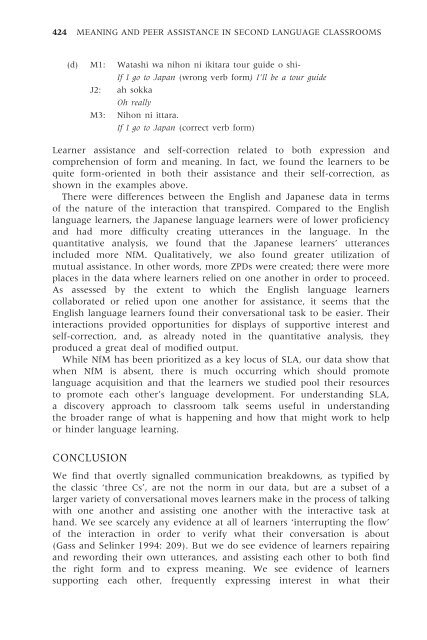Negotiation for Meaning and Peer Assistance in Second Language ...
Negotiation for Meaning and Peer Assistance in Second Language ...
Negotiation for Meaning and Peer Assistance in Second Language ...
Create successful ePaper yourself
Turn your PDF publications into a flip-book with our unique Google optimized e-Paper software.
424 MEANING AND PEER ASSISTANCE IN SECOND LANGUAGE CLASSROOMS<br />
(d) M1: Watashi wa nihon ni ikitara tour guide o shi-<br />
If I go to Japan (wrong verb <strong>for</strong>m) I’ll be a tour guide<br />
J2: ah sokka<br />
Oh really<br />
M3: Nihon ni ittara.<br />
If I go to Japan (correct verb <strong>for</strong>m)<br />
Learner assistance <strong>and</strong> self-correction related to both expression <strong>and</strong><br />
comprehension of <strong>for</strong>m <strong>and</strong> mean<strong>in</strong>g. In fact, we found the learners to be<br />
quite <strong>for</strong>m-oriented <strong>in</strong> both their assistance <strong>and</strong> their self-correction, as<br />
shown <strong>in</strong> the examples above.<br />
There were differences between the English <strong>and</strong> Japanese data <strong>in</strong> terms<br />
of the nature of the <strong>in</strong>teraction that transpired. Compared to the English<br />
language learners, the Japanese language learners were of lower proficiency<br />
<strong>and</strong> had more difficulty creat<strong>in</strong>g utterances <strong>in</strong> the language. In the<br />
quantitative analysis, we found that the Japanese learners’ utterances<br />
<strong>in</strong>cluded more NfM. Qualitatively, we also found greater utilization of<br />
mutual assistance. In other words, more ZPDs were created; there were more<br />
places <strong>in</strong> the data where learners relied on one another <strong>in</strong> order to proceed.<br />
As assessed by the extent to which the English language learners<br />
collaborated or relied upon one another <strong>for</strong> assistance, it seems that the<br />
English language learners found their conversational task to be easier. Their<br />
<strong>in</strong>teractions provided opportunities <strong>for</strong> displays of supportive <strong>in</strong>terest <strong>and</strong><br />
self-correction, <strong>and</strong>, as already noted <strong>in</strong> the quantitative analysis, they<br />
produced a great deal of modified output.<br />
While NfM has been prioritized as a key locus of SLA, our data show that<br />
when NfM is absent, there is much occurr<strong>in</strong>g which should promote<br />
language acquisition <strong>and</strong> that the learners we studied pool their resources<br />
to promote each other’s language development. For underst<strong>and</strong><strong>in</strong>g SLA,<br />
a discovery approach to classroom talk seems useful <strong>in</strong> underst<strong>and</strong><strong>in</strong>g<br />
the broader range of what is happen<strong>in</strong>g <strong>and</strong> how that might work to help<br />
or h<strong>in</strong>der language learn<strong>in</strong>g.<br />
CONCLUSION<br />
We f<strong>in</strong>d that overtly signalled communication breakdowns, as typified by<br />
the classic ‘three Cs’, are not the norm <strong>in</strong> our data, but are a subset of a<br />
larger variety of conversational moves learners make <strong>in</strong> the process of talk<strong>in</strong>g<br />
with one another <strong>and</strong> assist<strong>in</strong>g one another with the <strong>in</strong>teractive task at<br />
h<strong>and</strong>. We see scarcely any evidence at all of learners ‘<strong>in</strong>terrupt<strong>in</strong>g the flow’<br />
of the <strong>in</strong>teraction <strong>in</strong> order to verify what their conversation is about<br />
(Gass <strong>and</strong> Sel<strong>in</strong>ker 1994: 209). But we do see evidence of learners repair<strong>in</strong>g<br />
<strong>and</strong> reword<strong>in</strong>g their own utterances, <strong>and</strong> assist<strong>in</strong>g each other to both f<strong>in</strong>d<br />
the right <strong>for</strong>m <strong>and</strong> to express mean<strong>in</strong>g. We see evidence of learners<br />
support<strong>in</strong>g each other, frequently express<strong>in</strong>g <strong>in</strong>terest <strong>in</strong> what their














